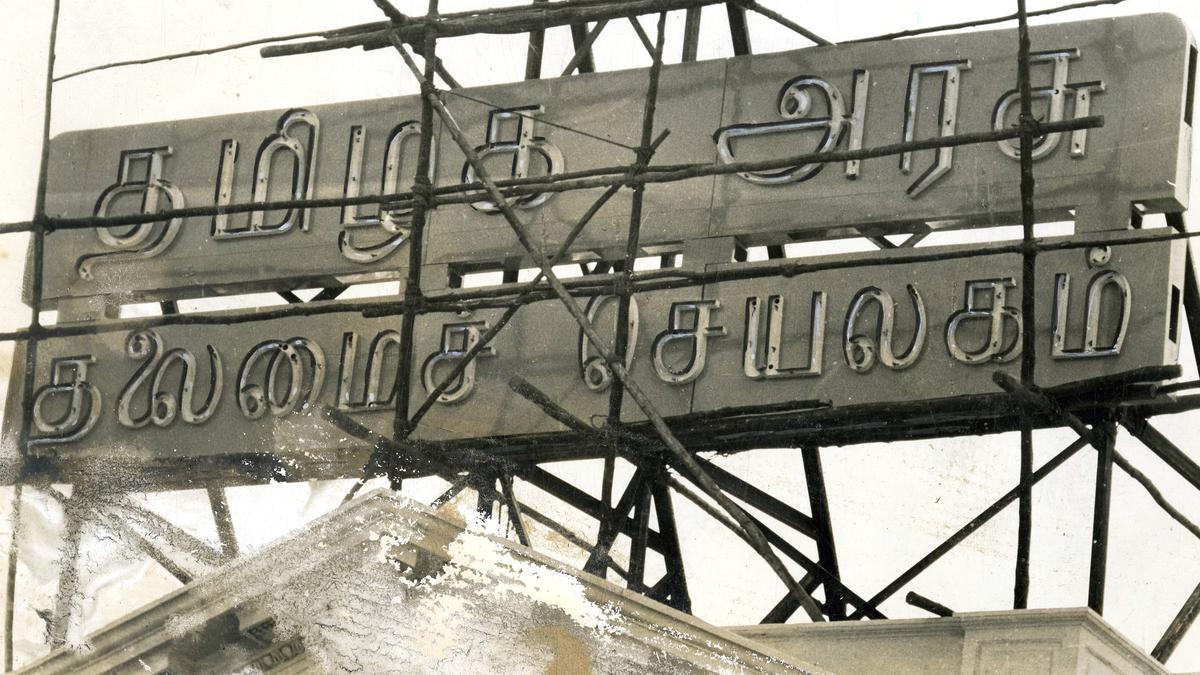
The less talked-about change of nomenclature — from Madras State to Tamil Nadu in 1961
The Hindu
Tamil Nadu's name change from Madras in 1969 was a result of political movements and linguistic demands.
The change in the nomenclature of Tamil Nadu, originally known as Madras, came into effect on January 14, 1969, a few weeks before the death of the DMK’s first Chief Minister, C.N. Annadurai. But, years before the 1968 law renaming the State came into being, the Congress government, led by K. Kamaraj, decided to use the title, Tamil Nadu, for the State while referring to it in Tamil.
In fact, for the purpose of clarity, the government had even decided that the official use of the name, Chennai, in Tamil should in future be limited to the city of Madras. Finance Minister and Leader of the House C. Subramaniam (CS) made an announcement to this effect in the Legislative Assembly on February 24, 1961. Recalling this episode in his biography on Kamaraj (Kamaraj: Oru Sahaptham), Congress leader A. Gopanna mentions that CS had cited the example of Germany to clarify possible doubts that some might entertain over the advisability of using two names for the State. World over, the European country is being called Germany, whereas Germans call their country Deutschland.
When CS went to the Assembly the next day to present the Budget for 1961-62, he said that in pursuance of the announcement the previous day, he had substituted Tamil Nadu for Madras in the budget document. It was he who created history on December 17, 1956, by making his budget (vote on account) speech in Tamil for the first time. P. Jeevanandam, one of the doyens of the Communist movement in the country, welcomed the Tamil speech, according to Tamizhar Nidhi Nirvagam, a historical document brought out recently by the State Finance Department.
In the Legislative Council on March 13, 1961, Industries Minister R. Venkataraman (RV) was grilled by three Members — A. Srinivasan, A. Chidambaranathan, and Md. Raza Khan — over the government’s move. A report in The Hindu said that when the ever-relentless Srinivasan asked the Minister whether the word, ‘Tamizh Nadu’, was known before Subramania Bharati, the latter retorted that he was “no expert on these matters”. (Annadurai had an answer to this question which he, however, provided in a debate in the Rajya Sabha in May 1963. He pointed out that the terms, Tamil Nadu and Tamizhagam, were used in the classical Tamil literary works, Paripadal, Pathitrupathu, Silappathikaram, and Manimekalai). When Chidambaranathan quizzed RV about the amendment to be made to the Constitution for the change, the reply was that ‘Madras State’ would remain in the Constitution. To Raza Khan’s question on when the government took the decision, before or after the launch of agitations for the name change, the Minister’s answer was short: “They are all confidential matters.” When Srinivasan questioned the government about the guiding principle for the name change, CS went to the rescue of RV, saying the Member should not indulge in insinuations.
It was not that the name, ‘Tamizhagam’, was unknown to the Congress government of the 1950s and 1960s. On April 21, 1959, the second day of the Assembly session in Udhagamandalam, Speaker U. Krishna Rao announced that the government had decided to rename the Arranmore Palace [the venue of the session] as Tamizhagam. This move figured during the Question Hour of the Council on May 9 when a member asked the government whether the changing of the name of the Arranmore Palace was a prelude to the renaming of the State. Materials provided by The Hindu archives showed that RV, who was also the Leader of the House, replied that the government did not want to put “any fetters on the imagination” of members.
But the Kamaraj government’s measures were not on their own. Ever since the re-organisation of the States on linguistic lines, the demand for the name change had emerged in certain quarters. In the Assembly, an attempt to rename the State, at the time of adoption of the States Reorganisation Bill in March 1956, was made, but the proposed amendment was defeated by a majority of 41 votes, according to records of the Assembly. Five years later, when CS announced the name change, it was in response to a non-official motion brought in by P.S. Chinnadurai of the Praja Socialist Party (PSP), who was elected from Palladam. M.P. Sivagnanam, a prominent Tamil scholar, who did not see eye to eye with Kamaraj, had been running a campaign for the name change. He argued that he was against the continuance of a colonial practice and it was not his aim to quarrel with the Congress.
In October 1956, K.P. Sankaralinga Nadar, a Virudhunagar-based Congressman, died after observing a fast for 75 days. Besides demanding that the Ministers in Tamil Nadu adopt “simple lifestyle”, he called for the name change. However, his death, which was similar to Potti Sriramulu’s in December 1952 in support of the creation of the Andhra State, did not evoke any immediate favourable response from the State government. The PSP and the DMK called a hartal in Madurai city. The Municipal Council too had an agitated debate on the unfortunate event. In Chennai, over 1,000 students of Pachaiyappa’s College abstained from classes on October 15 and took out a procession.

The Tamil Nadu government has amended its prayer in a writ petition filed before the Madras High Court against the search and seizure operation carried out by the Directorate of Enforcement (ED) at the Tamil Nadu State Marketing Corporation (TASMAC) headquarters in Chennai between March 6 and March 8, 2025.

 Run 3 Space | Play Space Running Game
Run 3 Space | Play Space Running Game Traffic Jam 3D | Online Racing Game
Traffic Jam 3D | Online Racing Game Duck Hunt | Play Old Classic Game
Duck Hunt | Play Old Classic Game










